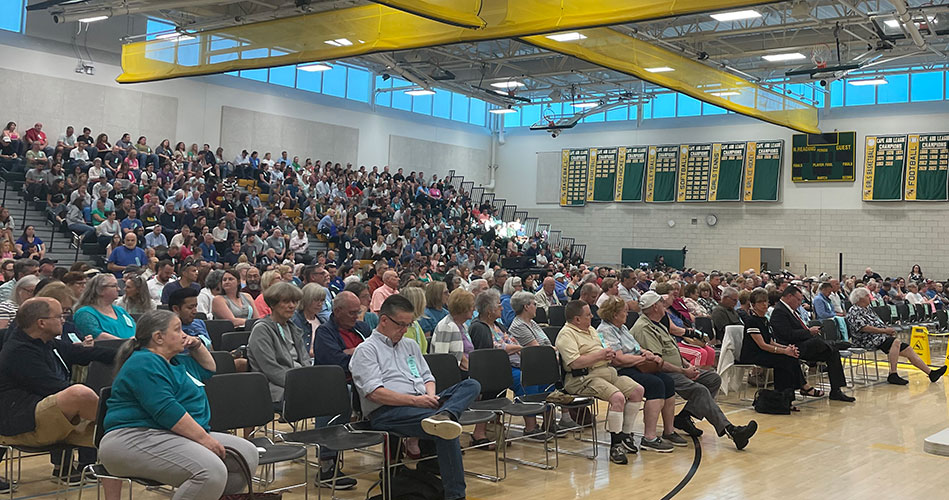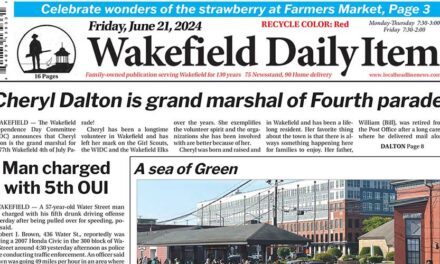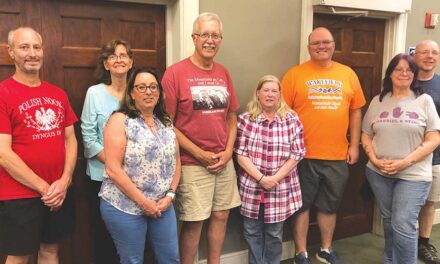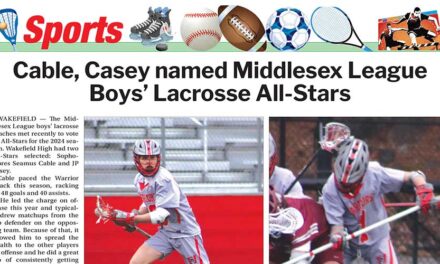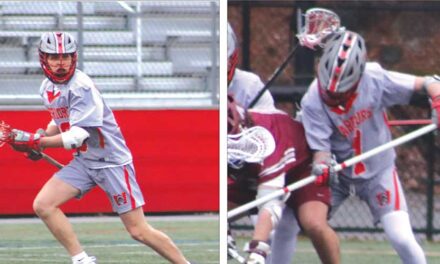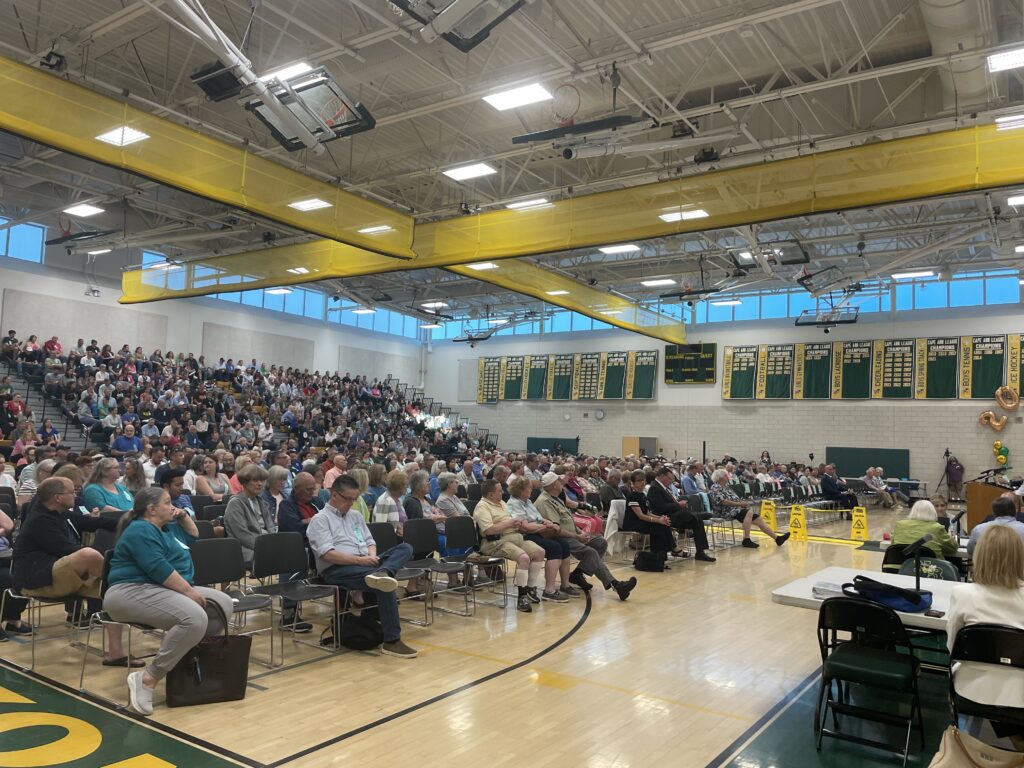
VOTERS packed the gymnasium at NRHS for the first session of the annual June Town Meeting Monday night. A total of 811 voters attended. Twenty-five voters stood to call for a paper ballot for the vote on the Prop. 2 1/2 override budget, which passed 555-181. (Maureen Doherty Photo)
By MAUREEN DOHERTY
NORTH READING — The voters have spoken. At least those who were in attendance at Town Meeting on Monday night.
By a margin of 555 to 181, the Proposition 2 1/2 override budget was favored by the majority to fund upwards of $10M over the current levy limit, potentially resetting the town’s bottom line for the next three years to avoid what has been described by town officials as devastating cuts to services across all sectors of the town.
This is the first step in the process. In order to become reality, the Proposition 2 1/2 override budget still has another obstacle to overcome — the ballot box. A majority of the townspeople who cast a ballot in the Special Election next Tuesday, June 18 at St. Theresa’s Parish Hall also must vote in favor of the override budget and giving themselves a tax increase. (There are also two more days left to vote early at Town Hall — June 13 from 8 am to 8 pm and June 14 from 8 am to 1 pm.)
If successful at the ballot box, it will be the first time in 19 years that North Reading voters chose to override the limitations of Proposition 2 1/2 to fund the general operating budget. Other debt exclusion overrides have passed in prior years to fund rather large projects, such as the “new” NRHS, which is now 10 years old and renovation and expansion of both the Batchelder School and the police station side of the town’s public safety building. These generally have a lifespan of 20 to 30 years before the debt is retired.
Under this proposed override budgeting scenario, the $10 million “would affect all residential, commercial, industrial and personal taxpayers, and is proposed to be phased in over three years (subject to approval at Town Meeting each year),” according to Town Administrator Michael Gilleberto.
Gilleberto also pointed out that “in the absence of a Proposition 2 ½ Override, debt for the Chestnut Street and Burroughs Road bridges/culverts, as well as the Fire Department ladder truck, will likely need to be funded through a Debt Exclusion tax increase as soon as this fall.”
The override funds in the three years would be earmarked toward the first year of the debt service for the Chestnut Street and Burroughs Road bridges ($348K each), fire dept. ladder truck debt service ($153K); maintain current municipal budget and services ($1.4M), maintain current school budget and services ($3.39M) and recurring fixed costs ($2.6M). Plus $400K in future capital needs; $1.18M in new municipal initiatives and $744K in new school initiatives which totals $10,579,498 with the 2.5% also factored into the equation.
The tax impact of the override on each property owner can be calculated at a rate of $2.12 per $1,000 of valuation over three years by taking the taxpayer’s assessed value, dividing it by $1,000 and multiplying the result by $2.12.
Taxpayers first should factor in the annual 2.5% property tax increase allowed each year under Prop. 2 1/2 to determine their total tax bill.
To provide a concrete example, town officials have been using the most current assessed value of the average single family home in town, which is $811,899. To start, this average home will see a tax increase of approximately $250 annually without an override.
The town’s FY25 budget is as follows:
- $90,627,932 to be raised and appropriated within the limitations of Proposition 2½
General Government: $35,657,822
Education: $39,871,531
Debt Service: $7,260,470
Enterprises: $7,838,109
- $2,885,227 contingent on a Proposition 2 ½ Ballot Election scheduled for June 18, 2024
General Government: $595,109
Education: $1,436,318
Debt Service: $800,000 (replaces $800,000 transfer)
Enterprises: $53,800
In the first year of the override, in order for the town to raise an additional $2.3M ($800K fixed costs, $375K in municipal costs and $1.2M in school costs) add $406 to the average home’s tax bill to cover the level services budget plus another $89 to cover a $510,000 shortfall for additional municipal and school expenses for a total of nearly $500.
While the FY26 and FY27 budgets have not been finalized, projected expenses see a need to raise a total of $3.4M in FY26 to cover fixed cost increases of $2M, municipal budget increases of $486K and school increases of $1.09M minus level growth of $250K, to keep services levels, which would have a tax impact of $593 plus another $89 for the second year of covering those additional needs for at total of $682.
In FY27, the override budget would fund $2.3M to provide level services ($958K in fixed costs, $545K in municipal costs and $1.1M in school costs minus levy growth of $256K.) The tax impact would be $406 plus $146 to fund $910K in additional needs ($676K municipal and $235K in school funds) for a third-year impact estimated at $552. The total impact over three years is $1,729 extra for an average of $144 per quarter over those three years.
Prior to getting to the 555-181 vote, the voters were presented and approved the non-override budget that stay within the limits of Prop. 2 1/2 but would result in immediate cuts to services. The equivalent of over 15 teaching and paraprofessional positions are on the chopping block and Superintendent of Schools Dr. Patrick Daly stated that he has already had very difficult conversations with about 10 staff members in the past week who would be affected. Whenever possible, their first approach is to not fill positions left vacant by retirements or staff members who leave the system and reassigning remaining staff to other positions. This is a strategy they’ve used over the years to balance past budget.
Passage of the override budget nearly carried on a voice vote. But the assessment of that voice vote made by Town Moderator John Murphy was challenged by voter Amy Sonia who called for a paper ballot. This process required a minimum of 25 voters to stand in solidarity with Sonia in calling for the paper ballot, which was achieved.
At that point many voters started to get up to leave. Murphy then explained the process in more detail. For a paper ballot, each voter was given a card with the words “yes” and “no.” They were called by sections of the room to put their choice in the ballot box and their throwaway in the discard box and then they had to exchange their colored voter ribbon to ensure they did not vote twice. Once completed, each ballot — yes and no — had to be hand counted. Each table had two to three election workers stationed throughout the process to ensure it was property observed. This process took well over an hour.
While the meeting began with a high of 811 voters, only 736 votes were tallied as several people chose to leave, many of whom had children on the premises as the NRHS student council provided free childcare services during the meeting.
Murphy explained to those voters getting up to leave that it would be possible for a voter to request a vote to be reconsidered prior to the end of that night’s business so if they left believing “their side” had prevailed, if enough of the voters on the “winning” side had left the outcome could be reversed.
No new business is taken up at Town Meeting after 11 p.m. and votes for considering of prior actions taken cannot be done at the next session of Town Meeting, which was proposed to be scheduled for Tuesday, June 11.
As a result of this possibility, as soon as the vote tally was announced a voter stepped to the microphone to request a motion to adjourn. He was informed that his motion would need to be in writing and to a date and time certain, which he ultimately did for 7 p.m. the next night.
The voters completed the second half of the warrant at the second session. Look for the results of the override vote and the other 33 Town Meeting articles in next week’s Transcript.

